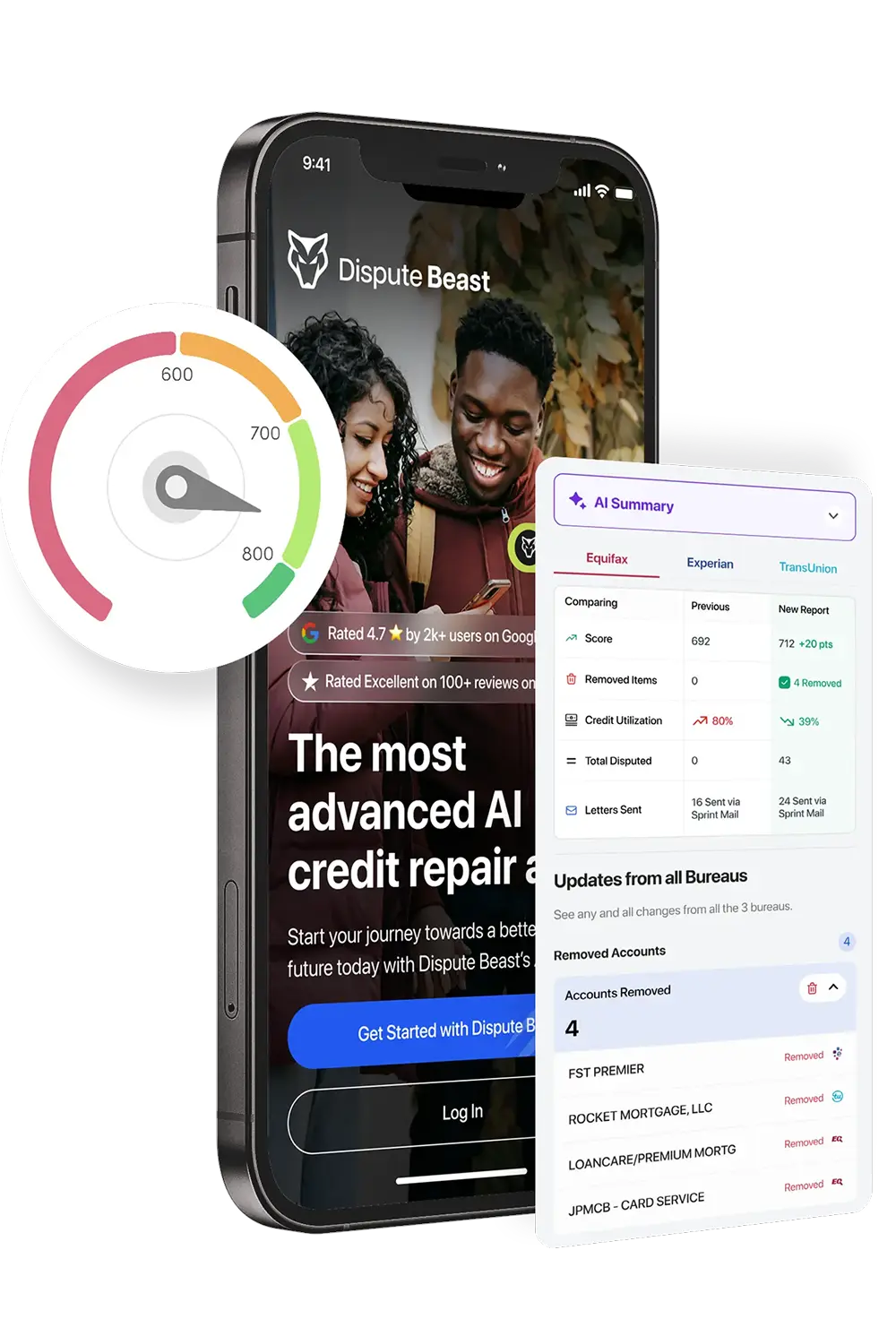Found mistakes on your credit report? Disputing errors with the credit bureau is essential for a healthy credit score. This guide explains how to dispute inaccuracies, step-by-step, ensuring you know how to dispute to credit bureau effectively, so your financial records are accurate and up-to-date.
Key Takeaways
Regularly checking your credit report is essential to identify inaccuracies and protect against identity theft.
Disputing errors with credit bureaus requires detailed documentation and can be conducted online or via mail for efficiency.
Utilizing automated tools, such as Dispute Beast, can streamline the dispute process and enhance credit repair efforts.
Understanding Your Credit Report

Your credit score and report are vital indicators of your overall financial condition, influencing your ability to obtain loans or credit. An accurate credit report impacts not just borrowing ability and interest rates but also employment, insurance, and housing opportunities. Ensuring your credit report accurately reflects your credit file can help you avoid potential issues when applying for loans or other forms of credit report based.
When you check your credit report, you’re looking at a detailed history of your financial activities. This includes personal details, account information, and records of your credit behavior. Common errors to watch for include:
Discrepancies in personal details like name, address, and phone number
Closed accounts mistakenly reported as open
Accounts incorrectly labeled as late or delinquent
Duplicate listings of the same debt These inaccuracies can significantly affect your credit score and, consequently, your financial opportunities.
Regular checks on your credit report can help you spot identity theft early on. You can access free credit reports through AnnualCreditReport.com, making it easier to stay on top of your credit status. Understanding and monitoring your credit report ensures that your financial record is accurate and up-to-date, paving the way for better financial health.
Identifying Inaccurate Information
Inaccuracies in credit reports can result from human errors or incorrect information from creditor reporting, emphasizing the need for regular checks. Regularly monitoring your credit report is crucial for spotting inaccuracies and potential identity theft. Identifying and disputing these errors helps prevent negative impacts on your credit score and overall financial health.
Fraudulent accounts can appear on your report, often due to identity theft. To address this, you should:
Scrutinize your report for any unfamiliar accounts or transactions.
Dispute any incorrect or negative information promptly.
Obtain documentation and provide written verification to support your dispute and help correct any inaccuracies.
Steps to Dispute Errors with Credit Bureaus

Maintaining an accurate credit report involves disputing errors with credit bureaus. To do this:
Dispute the mistake with each bureau, as each bureau may hold different information.
Use common methods to dispute information, including online, by mail, or by phone.
Regardless of the method, provide clear explanations and supportive documents.
The dispute process involves notifying the credit reporting agency of the error and providing necessary documentation. Should your initial dispute be rejected, resubmit the request with additional supporting documents. Following a systematic approach ensures that your dispute is handled efficiently and accurately.
Preparing Your Dispute Request
The first step in the dispute process is preparing a thorough dispute request. To do this:
Gather supporting documents such as a letter from the creditor, billing statements, or canceled checks.
These documents enhance the credibility of your claim.
Submit copies rather than originals, as they will not be returned.
When submitting a dispute, provide the following detailed information:
Creditor’s name
Account number
Specific reason for the dispute
Any supporting documents
This detailed relevant information will help the credit reporting agency understand the nature of your dispute and investigate it more effectively.
Submitting Your Dispute Online
Submitting your dispute online is often the fastest and most convenient method. For a quick dispute process, visit the Experian Dispute Center where you can:
Submit corrections online
Use online platforms provided by credit bureaus that streamline the dispute process
Submit, track, and receive updates on your disputes efficiently
Complete all required fields and attach supporting documents when disputing online. This ensures your dispute is processed quickly and accurately, minimizing the time it takes to correct any errors on your credit report and attach supporting documents for filing your claim.
Mailing Your Dispute
For those who prefer to mail disputes, submit them to both the reporting business and the credit reporting company. Using certified mail provides proof of delivery and ensures your correspondence addresses are tracked. This method is particularly useful if you need a paper trail of your dispute process.
Retain copies of all correspondence, including Dispute Letter and responses, for your records. This documentation is crucial for follow-ups or if you disagree with the outcome.
What Happens After You Submit a Dispute?

After submitting a dispute, the process typically follows these steps:
Credit reporting agencies have 30 days to investigate.
If you provide additional information during the investigation, the credit reporting company may extend the investigation time by 15 days.
Upon completion, the credit reporting agency will send you a written notice of the results along with an updated credit report.
The dispute investigation can lead to various outcomes, such as verification, updates, or deletions of information on your credit report. These changes can significantly impact your credit score and financial opportunities while investigating your options.
Tracking Your Dispute Status

Staying informed about the progress of your dispute involves tracking its status. You can verify your dispute status on platforms like myEquifax, TransUnion Service Center, and Experian account. These platforms offer updates and notifications, keeping you informed at every stage.
For example, Equifax and TransUnion offer email notifications at different stages of the dispute process to notify you. Experian provides status updates through its Alerts section and email alerts. Submitting your dispute by mail or phone means you won’t receive updates during the investigation.
Possible Outcomes of Your Dispute
The results of a dispute can include adding, updating, or deleting items from your credit report. Personal information disputes may result in notations such as ‘added’, ‘updated’, ‘deleted’, or ‘remains’. Account details disputes can lead to outcomes like ‘processed’ or ‘remains’ based on verification.
If the disputed information is confirmed accurate, it will remain unchanged in the report. Changes from disputes can potentially improve your credit score, emphasizing the importance of following through with the dispute process.
What If You Disagree with the Outcome?
Disagreeing with the dispute investigation results gives you several options. You can file additional disputes if you believe the investigation did not address all inaccuracies. A consumer statement allows you to explain your side of the dispute directly within your credit report.
Submitting a dispute may lead to changes in your credit report, or the company reporting may contact the relevant business or lender directly for further investigation regarding the credit report dispute and business reporting. This ensures that your concerns are addressed comprehensively.
Monitoring Future Reports for Accuracy
Regularly monitoring your credit report can help detect unauthorized activities and safeguard your financial interests. Being proactive in monitoring your credit prepares you for significant financial decisions, ensuring you’re always ‘credit-ready’.
Consistent credit monitoring prepares you for major financial commitments, allowing for better loan terms and interest rates. Frequent checks on your credit reports help identify fraudulent activities promptly, as reported by the credit bureau.
Using Dispute Beast for Efficient Credit Repair

Resources like Dispute Beast significantly simplify managing and disputing credit report inaccuracies. Dispute Beast automates the creation of dispute letters using an AI engine, making the disputing process straightforward for users. The process involves:
Loading your credit report
Pressing one button to generate dispute letters
Repeating the process every 40 days
Dispute Beast continuously monitors and helps eliminate new negatives as they arise. Most users see results after 6–12 attack rounds while maintaining good financial habits.
Start your credit repair journey with a free copy Dispute Beast account at https://disputebeast.com. For guidance and resources along the way, check out our Help & Support section.
Empowering Yourself with Financial Knowledge
Being informed about credit reporting practices helps individuals take charge of their financial future. Knowledge of credit reporting helps consumers make informed financial decisions and improve their credit scores. The consumer financial protection bureau enables individuals to better understand credit reporting and make informed decisions.
Using resources that promote financial empowerment enhances one’s ability to navigate financial challenges. Focus on empowerment: with Dispute Beast, users control their financial future.
Summary
In summary, maintaining an accurate credit report is crucial for your financial well-being. From understanding your credit report to identifying inaccuracies, disputing errors, and monitoring future reports, each step plays a vital role in ensuring your credit report reflects your true financial behavior. Tools like Dispute Beast can simplify and enhance this process, making credit repair more accessible and efficient.
Remember, taking control of your credit report is an ongoing process that requires vigilance and proactive management. By staying informed and using the right tools, you can navigate the complexities of credit reporting and secure a healthier financial future.
Frequently Asked Questions
How long does the credit bureau have to investigate a dispute?
The credit bureau has 30 days to investigate a dispute, which can be extended by an additional 15 days if further information is supplied. It is important to keep track of these timelines to ensure prompt resolution.
Can I submit a dispute online?
Yes, you can submit a dispute online, as it is typically the fastest and most convenient method available.
What should I do if I disagree with the outcome of my dispute?
If you disagree with the outcome of your dispute, you may file additional disputes or append a consumer statement to your credit report to express your perspective. Taking these steps helps ensure your concerns are documented and considered.
How can I track the status of my dispute?
You can easily track the status of your dispute by using platforms such as myEquifax, the TransUnion Service Center, or your Experian account. This allows you to stay informed about the progress of your dispute effectively.
What is Dispute Beast, and how can it help me?
Dispute Beast is a DIY credit repair software that automates the creation of dispute letters, simplifying and streamlining the credit disputing process for users. It can help you effectively manage and resolve credit issues with ease.



